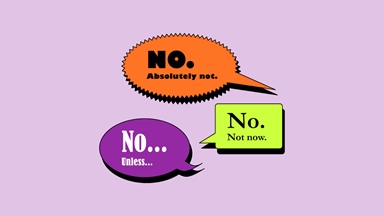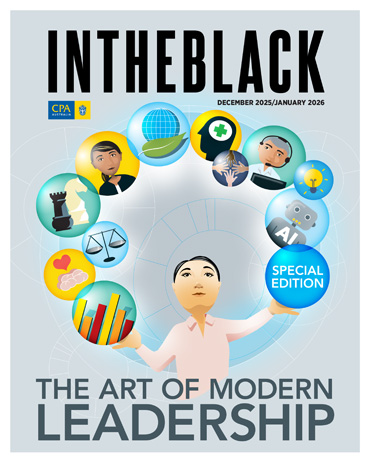Loading component...
At a glance
Navigating the workplace often requires a delicate balance between being helpful and maintaining personal boundaries.
While it may seem straightforward to say “yes” or “no” when asked to perform a task, declining a request requires nuance to ensure that workplace relationships are supported and strengthened. Understanding how to say “no” effectively is crucial for maintaining professionalism — and a manageable workload.
Three options
While saying “yes” or “no” is ostensibly binary, there are several potential approaches to saying “no” at work without conflict. The first is a “hard no”, which can be appropriate when a piece of work does not align to individual or organisational values.
“You might be asked to take a shortcut in a task you know is an integrity issue that is going to have a negative impact on the business, client or a person. Be clear that it is not possible for you to do what’s asked due to a mismatch of values,” says Shelley Johnson, founder of HR and leadership consultancy Boldside.
The second option is a “not-now no”, which is usually a sequencing or capacity issue. It is easy to get stuck on this option when everything feels like a priority.
A “not-now no” includes invitations to pointless meetings, Johnson says. “It is being able to say you’re not able to make the meeting because you’re not clear on the agenda. But, if they help you to understand the outcomes they want to achieve, you can see whether you’ll be able to attend.”
If what is being asked is not a priority at the time, it is not a “hard no”, but a timing issue. “Communicate that you need to press pause this time, but give a time horizon. You might indicate that you’ll be able to start work on the task in a couple of days, a week or a month,” Johnson adds.
The third option is a “no, unless…” situation. This is when a piece of work is important, but there are other factors that will impact its effectiveness.
“In this situation, you might say, ‘I’d like to help you, but I will need an additional resource or I’ll need to reduce my workload to be able to give the task the attention it needs’,” Johnson says.
How much of your personality should you bring to work?
Kindness counts
Context is particularly important when it comes to declining tasks at work. Being able to push back in a constructive way requires a solid relationship of trust between two parties that has developed over time.
“Being able to say ‘no’ is based on initiating positive dialogue in your workplace with your team leader and with your team around what you are doing, what you are contributing and how you spend your time,” says John Cooksey, business psychologist at Confident Performance.
“That should provide context for both parties in terms of whether you should say ‘no’ or even if you should be asked to do something in the first place.”
"Being able to say ‘no’ is based on initiating positive dialogue in your workplace with your team leader and with your team around what you are doing, what you are contributing and how you spend your time."
Regardless of how the “no” is delivered, Cooksey says the important thing is to remain professional, especially when being asked to complete a task by someone who may not be aware of your full workload. This can easily happen in organisations where managers have authority to assign work to dotted line reports.
“It is important to be able to say ‘no’ with as little emotion as possible. You can be assertive and empathetic, while also suggesting alternatives or improvements to the solution being proposed,” Cooksey says.
Similarly, leadership coach and author of The Empathy Gap, Daniel Murray, explains that saying “no” with a smile goes a long way.
“We don’t want to let people down, so we think we should say ‘yes’. Saying ‘no’ with a smile can help you feel like you’re not disappointing whoever is making the request,” he says.
The importance of framing
When it comes to assertive communication in the office, another tip is to reframe the response when saying “no”.
“When someone asks us to do something, often the reality is we can’t. We tend to say ‘yes’ and regret it because we don’t actually have time. Then, we struggle to do the work or we don’t do a very good job, or we become frustrated and resent the person who asked us to do it,” Murray says.
“In fact, we lie to them because we don’t have the capacity to take on the job. Unless we want to represent ourselves as liars, we need to take ownership,” he says.
Rather than saying “yes” when someone makes a request, be honest from the start.
Murray recommends using the acronym SQRT (pronounced squirt), which stands for scope, quality, resources and time, to negotiate an overwhelming task.
“You could say, ‘It sounds like what you’ve asked me to do is increase the scope of the project and I can do that. But I need to either reduce the quality, increase the resources or increase the time to complete it. What would you like to do?’,” he advises.
That creates clarity about the request, its implications and the consequences, effectively putting the choice back in the client’s or manager’s hands. Without taking this step, the choice about how to best approach the task is taken out of the hands of the person enacting the work.
“That is where framing becomes important. Sometimes saying ‘no’ is about being honest and open with people so they can make a better decision,” Murray says.
Work messages: professional tips on when to reply
Always assume good intent
While it is easy to become irritated when asked to do something outside an initial brief, it is important to assume the person making the request is doing so with good intent.
“They’ve asked you because they need some help, and they think you’re a good person to help them,” Murray notes. “It’s nice to be thought of that way. So, if you can’t help them, reply with kindness and reciprocate that good intent.”
While it can feel uncomfortable to reject a request, there are ways to approach effective refusal so that all parties leave the interaction better off. The idea is to be respectful and professional, and achieve an outcome that is positive for everyone.

